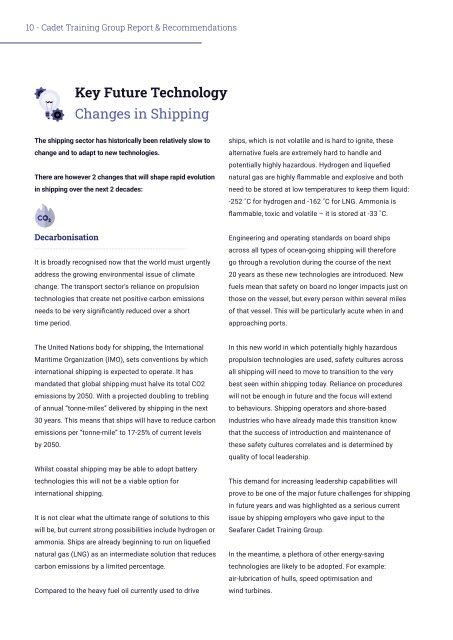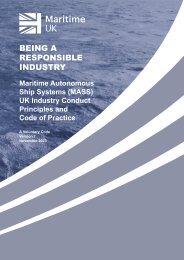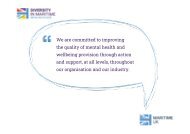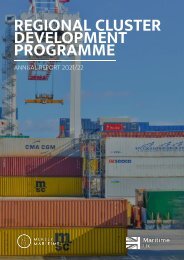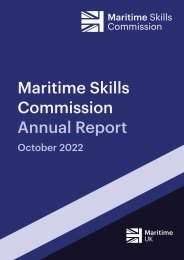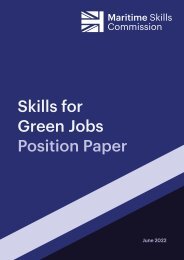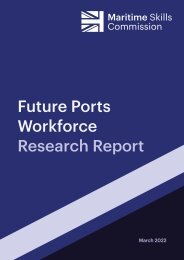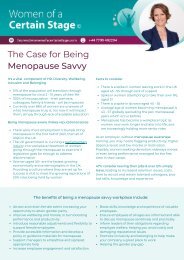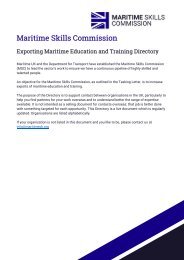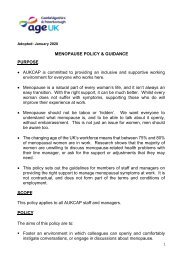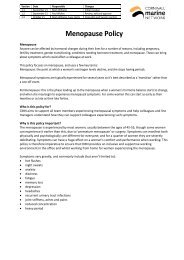Create successful ePaper yourself
Turn your PDF publications into a flip-book with our unique Google optimized e-Paper software.
10 - <strong>Cadet</strong> Training Group <strong>Report</strong> & <strong>Recommendations</strong><br />
<strong>Cadet</strong> Training Group <strong>Report</strong> & <strong>Recommendations</strong> - 11<br />
Key Future Technology<br />
Changes in Shipping<br />
The shipping sector has historically been relatively slow to<br />
ships, which is not volatile <strong>and</strong> is hard to ignite, these<br />
The impact of the decarbonisation imperative<br />
change <strong>and</strong> to adapt to new technologies.<br />
alternative fuels are extremely hard to h<strong>and</strong>le <strong>and</strong><br />
<strong>and</strong> accelerating technology <strong>and</strong> automation<br />
potentially highly hazardous. Hydrogen <strong>and</strong> liquefied<br />
Accelerating pace of<br />
on shipping will be profound over the next<br />
There are however 2 changes that will shape rapid evolution<br />
natural gas are highly flammable <strong>and</strong> explosive <strong>and</strong> both<br />
technology<br />
10-20 years – it has been described as being<br />
in shipping over the next 2 decades:<br />
need to be stored at low temperatures to keep them liquid:<br />
comparable to the transition of shipping from<br />
-252 ˚C for hydrogen <strong>and</strong> -162 ˚C for LNG. Ammonia is<br />
Technology in ships, as in every other area of life,<br />
sail to steam over 200 years ago.<br />
flammable, toxic <strong>and</strong> volatile – it is stored at -33 ˚C.<br />
is advancing at an accelerating pace. Shore-based<br />
control rooms already increasingly play a role in the<br />
Those onboard ships in the future will need<br />
Decarbonisation<br />
Engineering <strong>and</strong> operating st<strong>and</strong>ards on board ships<br />
operational decision-making <strong>and</strong> it seems likely that<br />
increasingly to be technologically highly<br />
across all types of ocean-going shipping will therefore<br />
functions such as engine monitoring will be increasingly<br />
capable <strong>and</strong> agile – able to learn about <strong>and</strong><br />
It is broadly recognised now that the world must urgently<br />
go through a revolution during the course of the next<br />
carried out remotely as it has been for some years in<br />
absorb new technology as it is adopted.<br />
address the growing environmental issue of climate<br />
20 years as these new technologies are introduced. New<br />
the aviation industry.<br />
Developing these competencies should become<br />
change. The transport sector’s reliance on propulsion<br />
fuels mean that safety on board no longer impacts just on<br />
a key part of future seafarer education.<br />
technologies that create net positive carbon emissions<br />
those on the vessel, but every person within several miles<br />
As use of automation in shipping accelerates, the ability<br />
needs to be very significantly reduced over a short<br />
of that vessel. This will be particularly acute when in <strong>and</strong><br />
of those on board to interface with the automation <strong>and</strong> to<br />
These changes are overlaid on a broader<br />
time period.<br />
approaching ports.<br />
intervene in the right way when the situation dem<strong>and</strong>s it<br />
movement in the economic centre of gravity<br />
becomes even more critical.<br />
towards Asia <strong>and</strong> the consequent need to adapt<br />
The United Nations body for shipping, the International<br />
In this new world in which potentially highly hazardous<br />
quickly in order to stay ahead in areas where<br />
Maritime Organization (IMO), sets conventions by which<br />
propulsion technologies are used, safety cultures across<br />
Parallel industries use the term “human-machine<br />
the UK holds current advantage.<br />
international shipping is expected to operate. It has<br />
all shipping will need to move to transition to the very<br />
teaming” as a way of highlighting that it is the interaction<br />
m<strong>and</strong>ated that global shipping must halve its total CO2<br />
best seen within shipping today. Reliance on procedures<br />
between the person <strong>and</strong> the technology that is changing.<br />
emissions by 2050. With a projected doubling to trebling<br />
will not be enough in future <strong>and</strong> the focus will extend<br />
of annual “tonne-miles” delivered by shipping in the next<br />
to behaviours. Shipping operators <strong>and</strong> shore-based<br />
Digital technologies, including automation, provide<br />
30 years. This means that ships will have to reduce carbon<br />
industries who have already made this transition know<br />
improved information <strong>and</strong> situational awareness with<br />
emissions per “tonne-mile” to 17-25% of current levels<br />
that the success of introduction <strong>and</strong> maintenance of<br />
the benefit of streamlining time-consuming <strong>and</strong>/or<br />
by 2050.<br />
these safety cultures correlates <strong>and</strong> is determined by<br />
dangerous tasks.<br />
quality of local leadership.<br />
Whilst coastal shipping may be able to adopt battery<br />
Advances in human-machine teaming are changing the<br />
technologies this will not be a viable option for<br />
This dem<strong>and</strong> for increasing leadership capabilities will<br />
nature of jobs by allowing people to focus on high-value<br />
international shipping.<br />
prove to be one of the major future challenges for shipping<br />
tasks including safety, decision making <strong>and</strong> problem<br />
in future years <strong>and</strong> was highlighted as a serious current<br />
solving. This transition is evident today in a wide range<br />
It is not clear what the ultimate range of solutions to this<br />
issue by shipping employers who gave input to the<br />
of professions from doctors to airline pilots.<br />
will be, but current strong possibilities include hydrogen or<br />
<strong>Seafarer</strong> <strong>Cadet</strong> Training Group.<br />
ammonia. Ships are already beginning to run on liquefied<br />
The nature of jobs in shipping will change with some<br />
natural gas (LNG) as an intermediate solution that reduces<br />
In the meantime, a plethora of other energy-saving<br />
potential re-balancing of what is done on board <strong>and</strong> what<br />
carbon emissions by a limited percentage.<br />
technologies are likely to be adopted. For example:<br />
is done remotely. This process of evolution will need to<br />
air-lubrication of hulls, speed optimisation <strong>and</strong><br />
be skillfully led <strong>and</strong> up-coming skills gaps identified <strong>and</strong><br />
Compared to the heavy fuel oil currently used to drive<br />
wind turbines.<br />
filled in a timely way.


